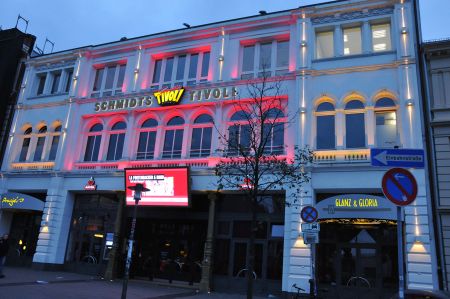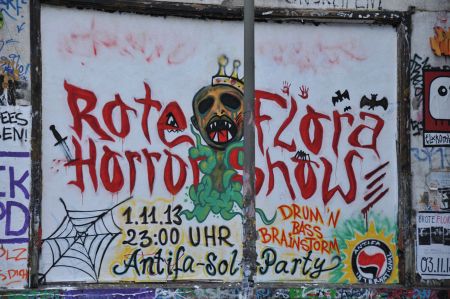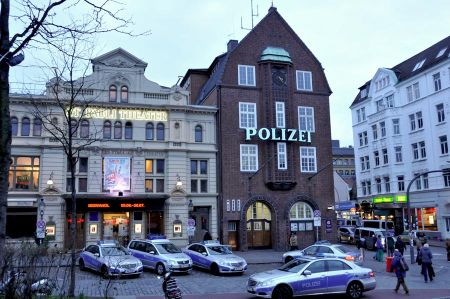Old St. Pauli-Elbtunnel and "Rote Flora" in Schanzenviertel
- Written by Portal Editor
Our visit to Bremen was coming to an end, two further appointments in Hamburg made the short trip to the nearby Hanseatic city necessary, which we were able to do quickly in the morning via the A1 motorway.
We went through the Elbe tunnel into the Hamburg Altona district, where we were able to park the vehicle directly at the Altona train station. Our passenger Laura had agreed to show us the Schanzenviertel, here in particular the autonomous cult or cultural center "Rote Flora" in the rest of the building of the former Flora Theater on the 71 shoulder blade.
Society and concert hall Flora

In 1855 the restaurateur H.F.P. Schmidt the site, had a new stage and an associated half-timbered rotunda built. In the garden there is a pond, various swings, animal cages and carousels for the children. The site was opened in 1859 as "Schmidt's Tivoli" and is said to have had 4,000 visitors for the occasion. The program on the stage offered farces, comedies and operas. Another change of ownership in 1869 brought with it the redesign and renaming to "Damm's Tivoli". Now "brilliant fireworks and Italian nights" were offered.

At the beginning of the century, the place of entertainment was given the so-called Flora March by the operetta composer Paul Lincke:
“Dora - come to the flora,
that has so many charms.
She lies on the shoulder blade,
is very close to you
the most beautiful variety show"
The demolition of most of the historic Floratheater in April 1988, especially the listed Crystallpalast from 1890, could not be prevented. Only the entrance area was to be preserved, behind it a new building with the new musical venue was to be built. But numerous actions, an occupation of the square in June 1988 and militant attacks against the construction site in September 1988 led to the investors giving up the musical project, at least at this point, despite daily police surveillance.
After the Rote Flora was officially opened on September 23, 1989, it was then declared occupied on November 1, 1989. Since then, the building has been used as a cultural and political meeting place. There are no paid positions, no funding, the project's concerns are organized within the framework of self-government. After a major fire in November 1995, the squatters did their own work to restore the Rote Flora, which continued to serve as a cultural district project and as a political center for autonomous groups in Hamburg. The Rote Flora is seen across Europe as a success story for an autonomous and anti-capitalist way of life in conscious resistance to the law. And to this day, if you look at the many international visitors to the Schanzenviertel in the cafes and restaurants, it can be seen as one of the city's real magnets, even if the future use of the Rote Flora is currently being hotly debated again.
After an invigorating cup of cocoa, we head along Budapester Straße in the direction of St. Pauli. Here a short photo stop at what is probably the most famous police station in the world, the Hamburg Davidswache, and the equally well-known Schmidts Tivoli Theater, we continue in the direction of the Elbe. We want to take a quick look at the old Elbe tunnel, when the Bosporus tunnel in Istanbul has just been opened to traffic. No, even though we walked right past the "Herbertstraße" access area, we didn't go inside. A few meters further we had arrived at the entrance building of the old Elbe tunnel.
The St. Pauli Elbe river Tunnel
In order to get the increasing flow of traffic on the Elbe under control, a permanent technical solution for crossing the Elbe had been considered since the end of the 19th century. The background was the enormous growth of the port of Hamburg and the associated shifts to the opposite side of the Elbe from the city. It was hoped that this would result in less disruption to shipping from crossing harbor ferries and an improved connection to the large shipyards on Steinwerder, such as Blohm & Voss, AG Vulcan and the Reiherstieg shipyard, as well as the transhipment points of the newly created harbor basin in the area of the free port.
A decision was finally made in 1901, and building officer Ludwig Wendemuth designed an Elbe tunnel. The tube was designed with a width of 4.7 meters and a minimum height of also 4.7 meters for a middle lane with a width of 1.82 meters (which corresponded to the gauge of horse-drawn carriages at the time) and two elevated footpaths with a width of 1.44 meters both sides. In this way, pedestrian traffic could flow undisturbed in both directions; the single lane should have been used alternately.
During construction under overpressure, three workers died from diving sickness and two more died in accidents. A total of about 4400 workers were employed. The plant caused construction costs of 10.7 million gold marks.
The tunnel was opened to pedestrian traffic on September 7, 1911 and to horse-drawn carriages and motor vehicles in November 1911. The press commented:
- "to speak loudly about how modern technology on land, on water and under water overcomes the tasks it faces" (Hamburger Fremdenblatt, May 21, 1911)
- "Its shape, not dissimilar to a mausoleum, is well suited to arouse brooding over its purpose in the viewer who has no idea of its purpose" (Deutsche Bauhütte, 1911)
- "as a contemporary thought flooded with the light and form-loving powers of modern contemporary taste, which is completely absorbed in the purpose, but in the realization of which nothing has been omitted that contributes to combining beauty with this purpose" (Hamburger Nachrichten, July 13 1911).
From October 5, 2009, a one-way road regulation similar to that of Sierichstraße was set up for car traffic. This means that from 5:30 a.m. to 1 p.m. there is one-way traffic from the St. Pauli Landungsbrücken to Steinwerder, and from 1 p.m. to 8 p.m. traffic flows back from the port to the city. During this period, cyclists have to adapt to the flow of traffic or push their bikes in the opposite direction. Due to the expansion of tourism and the growing range of leisure facilities in the southern port area, the numbers rose again. In 2008 around 300,000 motor vehicles, 63,000 cyclists and 700,000 pedestrians were counted.
Pedestrians and cyclists can still access the Old Elbe Tunnel free of charge and without time restrictions (with the exception of New Year's Eve from 9:00 p.m. to 4:00 a.m.), use by motor vehicles (motorized two-wheelers, cars, small trucks) is subject to a fee and at fixed opening times limited.
Since the large cruise ships have a draft of less than ten meters, they can use the Old Elbe Tunnel to reach the cruise terminal in the beach port, where the passenger halls of the Hamburg-America Line were located until the late 1930s. The large container ships cannot cross the tunnel due to their draft.
It's a strange feeling to enter the historic tunnel structure, even if there are certainly no security gaps. The interior of the elevators alone is absolutely worth seeing. We use one of the elevators down to the tunnel level, then crossed the tube that was open to traffic, which still has the traditional tiling on the walls, and climbed the stairs on the Elbe island of Steinwerder. The view of the Hamburg skyline was a dream despite or perhaps because of the onset of twilight. The many lights and the illuminated hustle and bustle on the Elbe let us linger for a moment before we went back through the tunnel to St. Pauli. A 100-year-old architectural masterpiece that is well worth a visit.
Please read as well:
Harbour tour on the Weser in Bremen
Harzer hiking needles - one system prevails!
https://www.alaturka.info/en/germany/hanseatic-hamburg/6025-old-st-pauli-elbtunnel-and-rote-flora-in-schanzenviertel/amp#sigProIdb4beb7e482
